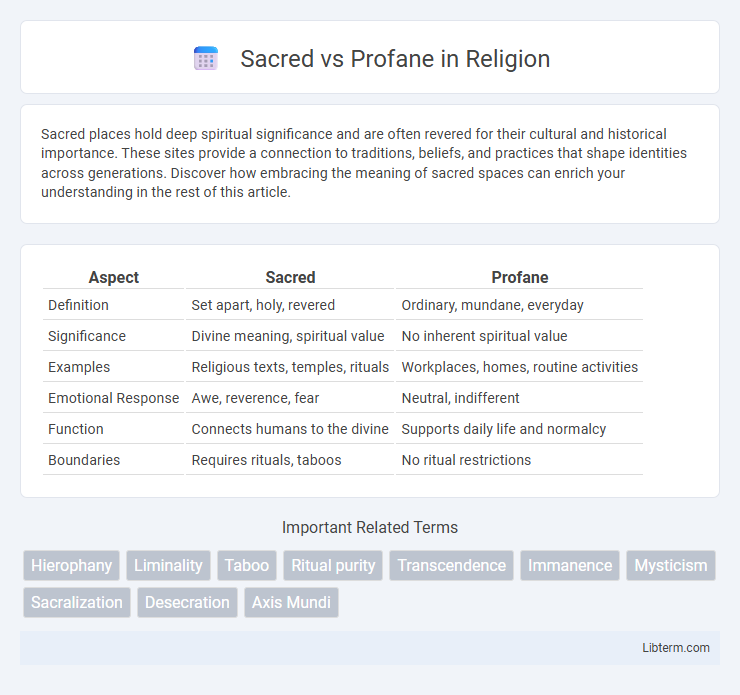Sacred places hold deep spiritual significance and are often revered for their cultural and historical importance. These sites provide a connection to traditions, beliefs, and practices that shape identities across generations. Discover how embracing the meaning of sacred spaces can enrich your understanding in the rest of this article.
Table of Comparison
| Aspect | Sacred | Profane |
|---|---|---|
| Definition | Set apart, holy, revered | Ordinary, mundane, everyday |
| Significance | Divine meaning, spiritual value | No inherent spiritual value |
| Examples | Religious texts, temples, rituals | Workplaces, homes, routine activities |
| Emotional Response | Awe, reverence, fear | Neutral, indifferent |
| Function | Connects humans to the divine | Supports daily life and normalcy |
| Boundaries | Requires rituals, taboos | No ritual restrictions |
Understanding the Concepts: Sacred and Profane
Sacred and profane are fundamental concepts in religious studies that distinguish between the extraordinary and the ordinary aspects of human experience. The sacred refers to things set apart and revered, often associated with divine presence, rituals, and symbols that evoke awe and respect. In contrast, the profane encompasses everyday, secular activities and objects that lack spiritual significance or sacred meaning.
Historical Roots of the Sacred-Profane Dichotomy
The sacred-profane dichotomy has deep historical roots in religious and anthropological studies, famously articulated by Emile Durkheim in "The Elementary Forms of Religious Life" (1912). Durkheim identified the sacred as elements set apart and forbidden, representing collective beliefs and social cohesion, while the profane encompasses ordinary, everyday life. This binary framework has since influenced the understanding of rituals, symbols, and social structures across diverse cultures and religions.
Key Philosophers and Theorists on Sacred vs Profane
Durkheim's seminal work in "The Elementary Forms of Religious Life" defines the sacred as elements set apart and forbidden, contrasting with the profane, which encompasses everyday, mundane life. Mircea Eliade further explores this dichotomy by emphasizing the sacred as a manifestation of ultimate reality that disrupts profane time and space, introducing hierophanies--sacred events or objects revealing the divine. Rudolf Otto contributes by highlighting the sacred's mysterium tremendum et fascinans quality, capturing the awe-inspiring and terrifying aspects that distinguish the numinous from the profane world.
Manifestations of the Sacred in Modern Society
Manifestations of the sacred in modern society often appear through symbols, rituals, and spaces that evoke deep reverence and collective identity, such as national monuments, religious gatherings, and cultural festivals. Sacredness is expressed in both traditional religious contexts and secular domains like art, music, and social activism, where transcendence and shared values are highlighted. These manifestations reinforce social cohesion and provide individuals with a sense of meaning and connection beyond the mundane or profane aspects of everyday life.
Examples of the Profane in Everyday Life
Everyday examples of the profane include mundane activities like commuting to work, grocery shopping, and routine household chores. These ordinary tasks lack religious or spiritual significance and are characterized by their functional and secular nature. Common objects such as smartphones, kitchen utensils, and office supplies also represent the profane in daily life.
The Role of Rituals in Defining Sacred Spaces
Rituals play a crucial role in distinguishing sacred spaces by creating structured actions that imbue locations with spiritual significance, separating them from ordinary or profane environments. These ceremonial practices, often repeated and symbolically charged, reinforce communal beliefs and facilitate encounters with the divine, transforming physical spaces into sanctified realms. The repetition and communal participation in rituals solidify the perception of holiness, marking the boundaries between the sacred and profane in religious traditions.
How Cultures Distinguish Between Sacred and Profane
Cultures distinguish between sacred and profane through symbolic systems that designate certain objects, spaces, and rituals as imbued with divine or spiritual significance, setting them apart from ordinary, everyday life. Sacred elements often require specific behaviors, taboos, and ceremonies to maintain purity and respect, reflecting cultural values and cosmologies. This dichotomy shapes social order by reinforcing boundaries and collective identity through shared reverence for what is considered holy versus what is mundane.
Sacred vs Profane in Art and Architecture
Sacred art and architecture embody spiritual significance, often designed to inspire reverence and symbolize divine presence through elements like temples, churches, and religious iconography. In contrast, profane art and architecture serve secular, everyday functions, emphasizing practicality, human experience, and cultural expression without direct spiritual connotations. The dichotomy between sacred and profane in art and architecture highlights how space, form, and symbolism can differentiate the holy from the ordinary in cultural landscapes.
The Impact of Sacred-Profane Boundaries on Social Norms
Sacred-profane boundaries shape social norms by distinguishing what is revered and protected from what is considered ordinary or taboo, influencing collective behavior and cultural rituals. These boundaries enforce community cohesion by guiding moral conduct and legitimizing authority through shared symbols and practices. Violations of sacred norms often result in social sanctions, reinforcing the significance of sacred constructs in maintaining societal order.
Contemporary Challenges to the Sacred-Profane Divide
Contemporary challenges to the sacred-profane divide arise from the increasing secularization and globalization that blur traditional boundaries between religious and everyday life. Digital media platforms often merge sacred rituals with profane contexts, leading to hybrid cultural expressions that question conventional distinctions. Social movements and pluralistic societies further complicate this divide by promoting diverse interpretations of what constitutes sacredness in modern settings.
Sacred Infographic

 libterm.com
libterm.com